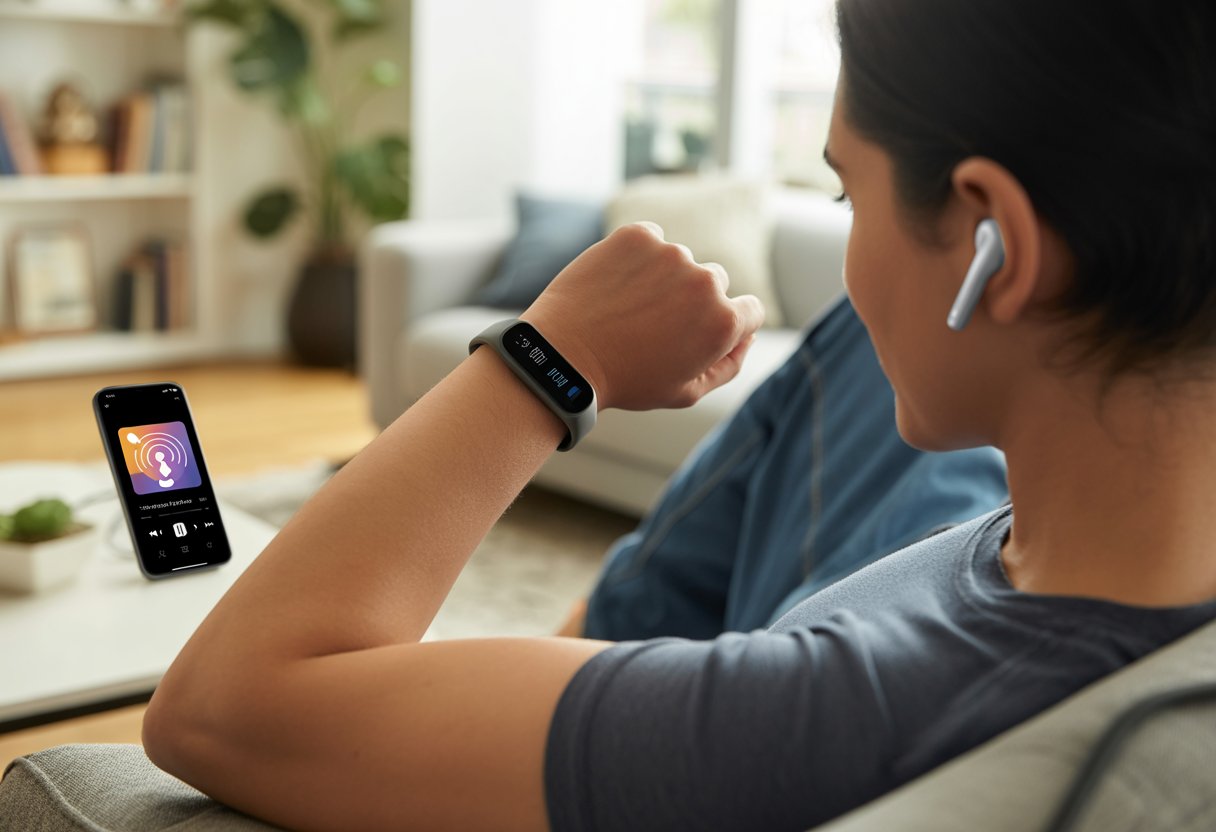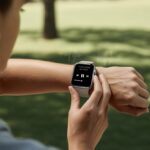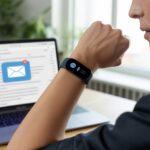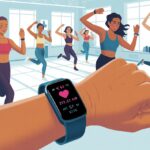Let’s be honest, our fitness trackers often end up as step counters we forget about. But why not get some fun out of them—like listening to our favorite podcasts while pretending cardio isn’t so bad? Most modern fitness trackers and smartwatches actually let us listen to podcasts right from our wrist. No more juggling phones or fighting with headphone cords at the gym.

We don’t need to be tech geniuses to pull this off. Devices like the Apple Watch or some Android Wear watches let us download podcasts or use apps to play them straight from the watch.
That’s a win for anyone who’s dropped their phone on a treadmill (been there, done that).
Let’s look at how to set up our fitness trackers for podcast listening. At least then we’ll have something to focus on besides how much we dislike burpees.
Getting Started With Your Fitness Tracker
Nobody wants to fumble with five gadgets just to jog and catch up on a podcast. Thankfully, most new fitness trackers can be both our fitness buddy and our entertainment hub.
We just need to pick the right tracker, connect it with our phone, and get those podcast episodes ready to go.
Choosing the Right Fitness Tracker
Not all fitness trackers are created equal, especially if we want to listen to podcasts while breaking a sweat.
Options like the Apple Watch and many Wear OS watches really shine for podcast fans. The Apple Watch stores and plays audio even when we leave our iPhone at home.
Wear OS options (like Fossil or TicWatch) let us install apps such as Wear Casts.
Fitbit models mostly stick to fitness tracking and usually don’t support direct podcast playback. We should check each Fitbit’s specs or plan to keep our phone nearby for audio features.
If podcasts are a must, it’s smart to make a checklist before splurging on a tracker:
- On-device storage for music or podcasts
- Third-party app support (Spotify, podcast apps)
- Bluetooth headphone compatibility
Before we dive into a purchase, let’s ask: Will this tracker let us laugh at our favorite host’s bad jokes while we sweat?
Pairing Your Tracker With Your Smartphone
Pairing is where our tracker and smartphone finally start working together. It’s essential for syncing podcasts, stats, and settings.
Most activity trackers use Bluetooth. Here’s what we do:
- Charge the tracker and turn on both the device and our smartphone‘s Bluetooth.
- Download the right app (like Apple Health for Apple Watch or Fitbit app for—yeah—Fitbit).
- Follow the on-screen instructions, usually involving a pairing code or approval tap.
Once connected, some trackers grab podcasts from our phone automatically. The Apple Watch syncs podcasts from the Apple Podcasts app; Wear OS can use apps like NavCasts or Wear Casts.
If things get weird, we restart both devices. Sometimes, that’s all it takes.
Installing Podcast Apps on Your Device
Now for the fun part: getting podcasts onto our wrists. If our fitness tracker supports apps, we get several podcast options.
On Apple Watch, we open the Watch app on our phone, check “Available Apps,” and install Apple Podcasts or Spotify.
For Wear OS trackers, we head to the Google Play Store on the watch and search for apps like Wear Casts or NavCasts. Download, and we’re set.
Here’s a quick table for options:
| Tracker | Built-in Podcast App | Install Third-Party Apps | Works Without Phone |
|---|---|---|---|
| Apple Watch | Apple Podcasts, Spotify | Yes | Yes (with storage) |
| Fitbit | No | Limited | No |
| Wear OS Watch | Varies (Wear Casts, etc.) | Yes | Yes (with storage) |
Let’s also make sure our tracker and headphones are paired, so we don’t end up blasting our true crime obsession to everyone at the gym.
Listening to Podcasts On the Go
We all want an easy way to listen to podcasts during a jog, walking the dog, or while dodging responsibilities on a brisk stroll. Fitness trackers make this possible, but getting everything set up can feel like trying to teach your grandma TikTok.
Let’s break it down step by step and keep things simple.
Syncing Podcasts to Your Fitness Tracker
We don’t need to haul around giant MP3 players anymore. Now, we just get our favorite podcasts—morning news, true crime, or even sandwich debates—onto our fitness tracker.
Most modern smartwatches and fitness trackers, like Apple Watch or some Samsung models, sync podcasts from apps like Apple Podcasts and Spotify right onto the device.
Apple Watch users have it pretty easy. We open the Watch app on our iPhone, tap on the Apple Podcasts app, and pick what we want to sync.
Spotify users can download specific episodes in the Spotify app and send them to the watch for phone-free runs.
Every brand does things a little differently. Some trackers want us to manually add files, while others sync over Wi-Fi or Bluetooth. If we get stuck, a quick peek at our watch’s settings or a helpful guide usually saves the day.
Connecting Headphones for a Seamless Experience
Tangled cords and pairing problems can really kill the vibe. Most fitness trackers support Bluetooth headphones, so we can ditch the old headphone jacks.
We pop our headphones into pairing mode and select them in the Bluetooth settings of the tracker.
If our device acts up, we flip Bluetooth off and on again—classic move. Sometimes only one earbud wants to work. It’s annoying, but it happens.
For the best connection, we keep the tracker and headphones close together. Thick coats and deep pockets can mess with Bluetooth signals.
Some watches have built-in speakers, but honestly, nobody else needs to hear our motivational podcasts unless we’re aiming for a crowd.
Optimizing Playback Settings
We don’t always have time to listen at normal speed—double speed is a real productivity hack. Most fitness trackers let us adjust playback speed, skip ahead, or rewind to catch what we missed.
Look for the settings icon while playing a podcast. Apple Podcasts and Spotify on Apple Watch both let us change speed or set a sleep timer.
We can pause playback by tapping the screen or using the crown or side buttons. No more awkward moments when our dog pulls us mid-episode.
If we go for long runs, adjusting volume and playback before we start saves us from fumbling mid-stride. Some trackers even offer gesture controls—just be careful not to wave at a neighbor and skip your episode by accident.
A simple interface is a lifesaver when we’re sweaty and trying to swipe with clumsy fingers. Most smartwatch podcast apps keep things straightforward.
Big play buttons, easy-to-swipe episode lists, and clear artwork help us find what we want without breaking our stride.
Apple Podcasts and Spotify on watches show our subscriptions, top episodes, and downloads with just a few taps. Some trackers let us organize podcasts in folders or favorite lists, which is handy when we can’t decide between health tips or comedy mid-run.
If the interface feels confusing, we can rearrange apps or update to the latest version. Lots of users share tips in online communities, and checking out user discussions about podcast support might help us solve stubborn problems or discover new features.
Navigation gets easier with practice—and fewer smudges on the screen.
Integrating Podcast Listening Into Your Workouts
Sometimes, it’s tough to decide what’s more important: tracking our steps or learning who really killed JFK. Good news, we can do both.
The right fitness tracker lets us monitor our stats while keeping podcasts in our ears, making workouts a lot less boring.
Tracking Your Activity While Listening
We can multitask like pros when we strap on an activity tracker. Most modern trackers let us play podcasts on apps like Spotify, Pocket Casts, or Apple Podcasts, all while tracking our steps, minutes, and sometimes our heart rate.
Platforms like Strava let us record every mile we travel while secretly binging true crime stories.
These gadgets show our heart rate, pace, and calories burned—sometimes right next to our play/pause button. No more awkward “oops, skipped a beat” moments; we just hit play and go.
Want podcast listening without phone juggling? Some trackers offer storage for offline audio, so we can leave our phones behind.
We can find models that support podcast controls on the band itself, so we never miss a twist in the story or a single heartbeat.
Motivating Your Exercise Routine
Let’s admit it: running gets way easier when we’re lost in a good podcast episode. Our trusty fitness trackers help us power through sweat sessions while learning random animal facts or catching celebrity interviews.
Podcasts break our workouts into chunks, making even long treadmill sessions feel shorter. It’s like tricking our brains into thinking we’re just hanging out with friends—except our friends are heart rate data and witty podcast hosts.
If we want more tips on breaking up workouts, we can check out how podcast workouts can help. Next time we need motivation, we cue up a podcast and let curiosity do the heavy lifting.
Balancing Music and Podcasts
Sometimes, we crave the thump of music. Other times, we just want someone talking in our ear about unsolved mysteries.
Finding a balance helps our workouts fit our mood—and our playlists.
Many fitness trackers let us switch between music and podcasts without losing workout data. We schedule podcast time during warm-ups or cool-downs and blast our favorite songs during sprints.
Some apps even let us queue podcasts and songs together, so we stay entertained from start to finish.
If we’re looking for ideas, there are lists of podcasts made just for workouts to keep us informed and in shape.
With a little planning, we get both the soundtrack and the storyline to keep our exercise fresh.
Essential Features for Podcast Fans
If you’ve ever taken your fitness tracker on a podcast marathon while pounding the treadmill, you know how much easy audio controls matter. Quick adjustments can really make or break the whole experience.
Features that let us spend less time fumbling with our wrists and more time actually running? That’s a real upgrade, honestly.
Pause and Play Controls
Let’s be honest—nobody wants to wrestle with an Apple Watch in the middle of a squat. Pause and play controls are essential for anyone who loves podcasts.
We need to pause when someone interrupts, and get right back to playing as soon as we’re ready. Most fitness trackers, like the Apple Watch and Fitbit, give us big, clear buttons for these controls.
We can stop the audio fast, even if our hands are sweaty or shaking from that seventh pushup. That’s a relief.
Here’s why this matters:
- Instant podcast control if something unexpected happens at the gym
- No need to fish out your phone and lose your flow
- Super easy to manage playlists or swap podcasts mid-workout
If a tracker’s buttons are tough to find or respond too slowly, it’s probably time for an upgrade. Responsive controls help us avoid missing out on surprise plot twists or those hilarious podcast moments.
Adjusting Volume and Skipping
Sometimes a podcast host’s laugh is so loud it drowns out the gym playlist. We need quick volume tweaks so the guy next to us doesn’t catch every joke.
Fitness trackers with easy volume controls let us keep things comfortable without breaking stride. Skipping is a must too.
If an episode drags or a long ad comes on, skipping ahead saves our sanity. The Apple Watch lets us flick to skip forward or back, while Fitbit and others usually offer a tap or swipe.
The perks:
- No need to grab the phone and risk dropping your water bottle
- Quick changes keep us locked in the podcast zone
- We can keep moving and not miss our favorite parts
If a tracker doesn’t have smooth volume or skip features, we’ll end up stuck with stuff we don’t want—or worse, miss the best moments. Easy controls mean our workouts and podcasts stay in sync.
Popular Podcast Platforms and Fitness Trackers
These days, it’s super easy to tune in to our favorite podcasts while racking up steps or running laps. With all the options out there, we can ditch the awkward pocket-juggling and stream straight from our wrist.
Using Spotify on Wearable Devices
Spotify is everywhere—on our phones, speakers, and, yeah, most newer fitness trackers. Devices like the Apple Watch and some Garmin smartwatches let us sync Spotify playlists and podcasts (think Stuff You Should Know) right to our wrists.
With the Spotify app, we can download episodes directly to the watch. No more phone bouncing around in your gym shorts.
All we need is a pair of Bluetooth headphones paired to the tracker, and we’re set. Managing downloads is usually pretty simple.
Not every tracker lets us stream without a phone, though. It’s always worth checking your tracker’s app features and keeping Spotify updated for the smoothest playback.
Exploring Apple Podcasts Compatibility
Apple Podcasts is the top pick for anyone in the Apple crowd. If you’ve got an Apple Watch, syncing podcasts is easy, and you can leave your phone behind for a run.
That’s perfect for squeezing in 30 minutes of Stuff You Should Know during a sweaty sprint. You add episodes to the watch using the Podcasts app on your iPhone.
Just grab your Bluetooth headphones and hit play. Some features, like streaming without a phone, only work on newer models.
It’s reliable and simple, as long as you set up syncing ahead of time. Apple Podcasts doesn’t play nice with every third-party tracker, so if you’re not using Apple gear, your options shrink.
Third-Party Podcast Apps
If Spotify and Apple aren’t your thing, third-party podcast apps save the day. Apps like Pocket Casts or Overcast work with several smartwatches and fitness trackers, and sometimes they offer fun extras like smart speed or silence trimming.
On devices like the Fitbit Versa, we control podcast playback through the music app. Right now, we still need to download episodes to our phone before transferring them.
Android users get more choices, but not every tracker can run these apps directly. Sometimes the phone has to play middleman.
Honestly, third-party podcast apps are a bit of a buffet. We have to test which ones work best with our device, maybe try a few, and sometimes we still have to carry our phone—unless our wearable supports direct downloads.
At least hunting for the perfect app means more steps, right?
Podcast Listening for Commuters and Cyclists
Commuting and cycling can get boring fast without something to listen to. Luckily, our fitness trackers let us tune in to favorite podcasts and make the ride more bearable—just don’t forget about safety.
Safe Listening While Commuting
We all love a good podcast episode during a long bus ride or while pacing down the sidewalk, pretending it counts as exercise. But safety comes first.
Open-ear or bone conduction headphones let us hear traffic and announcements, so we don’t miss our stop or end up starring in a viral video for walking into a fountain.
When we’re fiddling with a fitness tracker to play, pause, or skip, it’s best to set up a playlist before heading out. That way, we’re not risking thumb acrobatics in a crowd.
Also, keep the volume low enough to catch important sounds—like a honking horn or the sweet call of a coffee shop.
Pairing our tracker with our favorite podcast app (Spotify’s always solid) makes switching shows easy. No one wants to get stuck with a boring episode during rush hour.
Tips for Cyclists
Cycling and podcast listening can be risky if we’re not careful. Traditional earbuds block out too much, so it’s smarter to use bone-conduction headphones that keep our ears open.
This way, we can enjoy a plot twist and still hear that cyclist yelling “on your left!” Smartwatches and fitness trackers often have controls for skipping tracks or adjusting volume.
That means we keep our eyes on the road and hands on the handlebars—no circus tricks needed to dig out a phone. For long rides, download episodes ahead of time.
Weak signal in the countryside means no streaming, and nobody wants to be left alone with their thoughts for that long. If local laws ban headphones, stick with a small portable speaker, or just hum the podcast theme song and imagine the rest.
Tracking Your Listening and Exercise Data
If we’re tracking our steps but still tripping over headphone cables, something’s off. Fitness trackers help us spot patterns in workouts and podcast binges—even figure out if true crime makes us run faster.
Visualizing Trends and Analytics
Syncing up our tracker with exercise and podcast apps puts a world of colorful graphs at our fingertips. We can watch our heart rate spike during a plot twist or see how our pace changes with every episode.
Some apps, like Strava, show how our running routes and podcast listening habits line up. Tables and charts let us compare days we hit our step goals with days we finished a marathon interview podcast.
It’s kind of like detective work—except we’re picking clues from data, not magnifying glasses. By looking at daily, weekly, or monthly summaries, we can spot patterns, like which podcasts get us moving (and which ones make us stop just to laugh).
Joining the Quantified Self Movement
Let’s take things up a notch and dive into the Quantified Self movement.
Basically, you start tracking all sorts of details about yourself—like how many podcasts you squeeze in per mile, or whether your cardio slows down every time you hit a history episode.
When you share your exercise stats and podcast habits with others, you get to swap ideas and maybe even brag a little—especially if you managed to crush your best 5K during that wild, unforgettable episode.
Syncing up your fitness tracker data lets you line up heart rates, step counts, and favorite podcast episodes with friends.
It turns fitness into something social, a bit competitive, and honestly, almost scientific.
Plus, let’s be real: it’s probably the only way most of us will actually remember what happened in last week’s mystery podcast.
- How to use a smartwatch for ECG readings: Because Your Wrist Knows More Than Your Ex - November 1, 2025
- How to use a fitness tracker for podcast listening: Steps, Strides, and Satisfying Stories - November 1, 2025
- Bluetooth Headphones Error Code 201 Fix: Why Your Music Suddenly Hates You and How to Make Up - October 31, 2025






